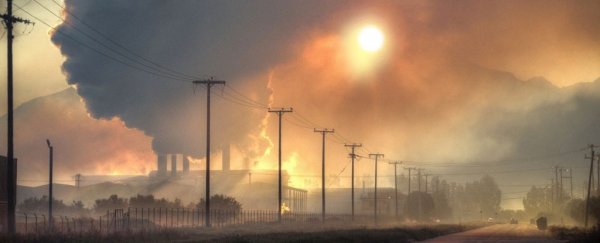As air pollution decreases in the western Northern Hemisphere, several new climate simulations suggest tropical cyclones in the Atlantic may increase. The forecast is troubling, though not necessarily a surprise.
When tiny aerosols like dust, soot, and sulfates are airborne, they create smog that can dim sunlight and cool Earth's atmosphere and surface.
Broadly speaking, that's opposite to the impact of greenhouse gasses, which trap energy from the Sun in our atmosphere and warm our planet.
Given the competing tug-of-war between these different forms of pollution, it's possible that anthropogenic aerosols have been masking some of the worst effects of global warming.
Research from the National Oceanic and Atmospheric Administration (NOAA) has now connected regional air pollution from industries and cars to storm activity around the world.
Over the past 40 years, international weather and pollution data show that aerosol control measures in Europe and the United States have seen pollution levels drop significantly.
By analyzing the results from several idealized climate simulations, researchers have shown that a decrease in pollution would have contributed significantly to an increase in tropical cyclones in the North Atlantic.
As aerosol particles in Europe and the US fell, the simulations suggest the mid-latitudes of the North Atlantic would have warmed. This, in turn, would have triggered a poleward shift in the subtropical jets, which reduces vertical wind shear and increases tropical cyclone activity.
Aerosols aren't the only factors in our planet's atmosphere that impact the frequency and severity of hurricanes, but the results suggest they do play a significant role. Decreasing aerosols by 50 percent in the US and Europe was linked to a 33 percent increase in hurricane formation.
In South and East Asia, however, the story is different. While aerosol pollution is on the decline now, it increased by 50 percent from 1980 to 2010.
Simulations suggest the dimming effect of all that pollution cooled temperatures and weakened monsoon circulation in the tropical western North Pacific. From 2000 to 2020, tropical cyclone activity decreased by 14 percent compared to the 20 previous years.
Despite this small reprieve from storms, increasing air pollution isn't a viable strategy for a clean and healthy future.
Reducing greenhouse gasses should still be our first line of attack. As climate change worsens, models suggest it is likely to make tropical storms slightly less common but more severe.
Air pollution simply wouldn't be able to keep up. It also comes with a host of other deadly issues.
"Air pollution is a major killer, so reducing emissions is critical no matter what happens with the number of cyclones," says University of Washington public health scientist Kristie Ebi, who wasn't part of the study.
In recent years, some scientists have proposed we try to artificially dim the Sun with billions of sulfur particles. But others worry if we tinker any more with the atmosphere, we will create an even bigger issue further beyond our control.
Earth's climate is a complicated, highly tuned system, and we've messed with it one too many times. But it's clear that whatever we do, the time to act is now.
The study was published in Science Advances.
